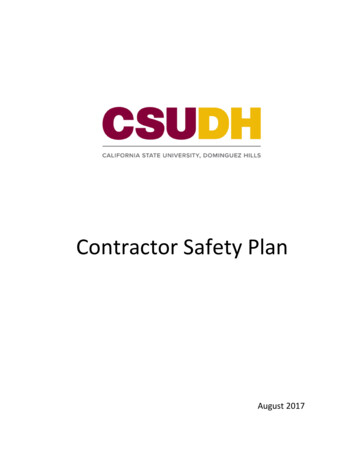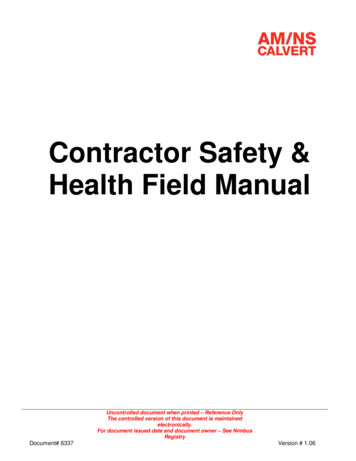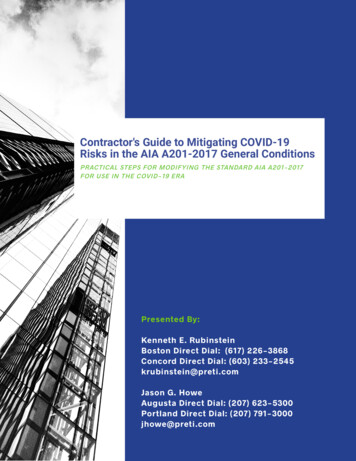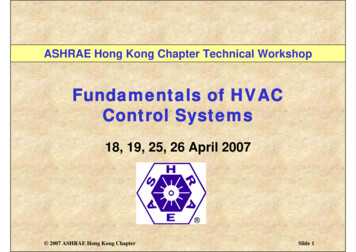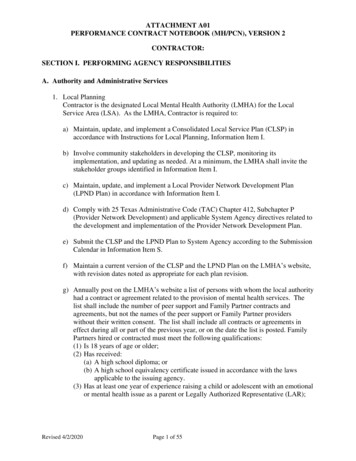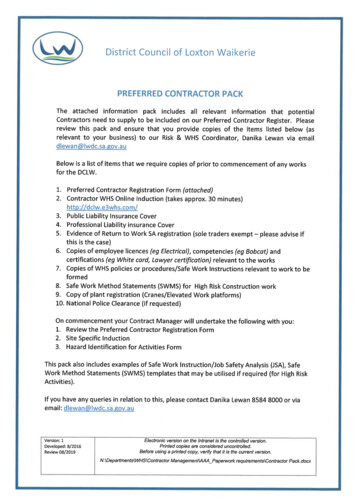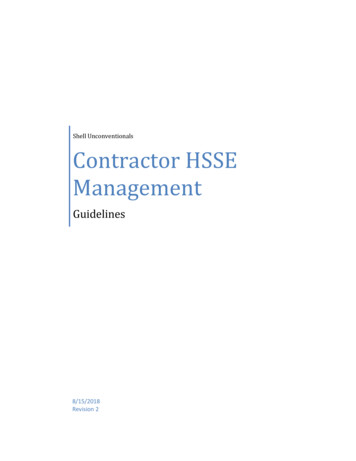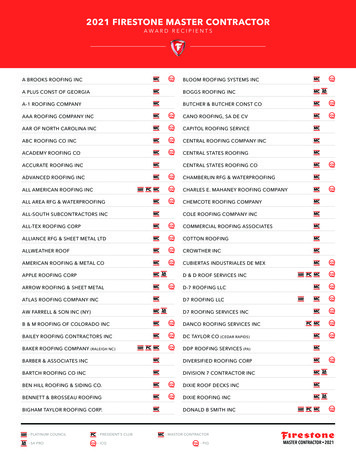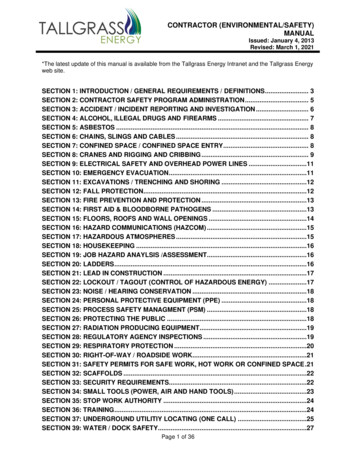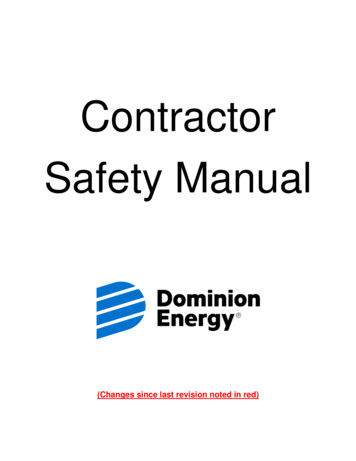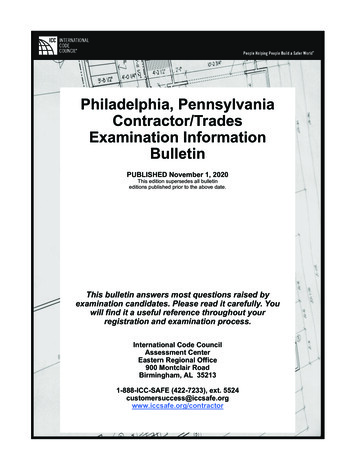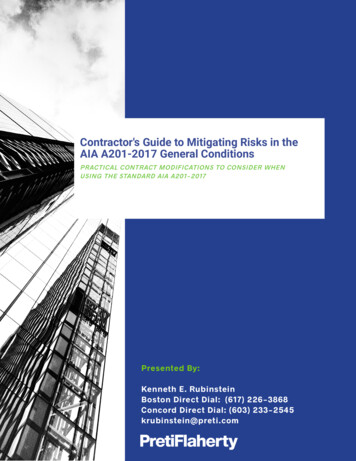
Transcription
Contractor's Guide to Mitigating Risks in theAIA A201-2017 General ConditionsPRACTICAL CONTRACT MODIFICATIONS TO CONSIDER WHENUSING THE STANDARD AIA A201-2017Presented By:Kenneth E. RubinsteinBoston Direct Dial: (617) 226-3868Concord Direct Dial: (603) 233-2545krubinstein@preti.com
Contractor's Guide to Mitigating Risks in the AIAA201-2017 General ConditionsPRACTICAL CONTRACT MODIFICATIONS TO CONSIDER WHEN USING THE STANDARD AIA A201-2017INTRODUCTIONThe AIA A201-2017 is generally a well understood contract documentused in a significant volume of construction each year. While the A2012017 covers most risks, there are a number of areas in which it exposescontractors to significant risk.This guide includes specific potential changes to the AIA A201-2017 thatcontractors should consider when trying to ensure that their contract fitstheir desired level of risk.Importantly, we do not recommend that all of the changes should beincorporated into every contract. Rather, this guide is intended as a toolfor contractors to identify risks in order to makean informed decision as to what risks the contractor is - and is not willing to accept.PLEASE NOTE: This guide was first created before the emergence ofthe coronavirus known as COVID-19. Accordingly, the document doesnot include edits addressing the risks that are specifically created by thecoronavirus. For a list of recommended edits to address COVID-19 relatedrisks, please see our Contractor's Guide to Mitigating COVID-19 Risks inthe AIA A201-2017 General Conditions.CONTRACTOR'S GUIDE TO MITIGATING RISKS IN THE AIA A201-2017 GENERAL CONDITIONS MAY 2020
Recommended Modifications to the AIA A201§1.1Order of PrecedenceAt the end of the section,add an order of precedence,stating, “In the event of anyconflict between or amongany of the ContractDocuments, the conflictshall be resolved inaccordance with thefollowing order, with the firstlisted document takingpriority: (a) change orders,(b) qualifications andassumptions, (c) the A201,(d) the A101, (e) drawings(with detailed drawingstaking precedence overlarge scale drawings).”If there is conflict, you want toknow what will take higher priority.There is no magic as to whichdocument comes first, as long asyou know so that you resolveconflicts correctly.§1.1.2Architect’s RightsRemove the last sentence ofthis paragraph.This change removes languagethat makes the architect thebeneficiary of the contract andentitled to enforce the contract.Neither the Owner nor theContractor have a vested interestin the Architect having the right toenforce the agreement – this likelyresults from the form beingcreated by the AIA.This document is provided as a reference only and should not be relied upon as legal advice. Each contractand circumstance is different, and you should consult with an attorney before relying upon this document.
Add§3.2.5Change in LawsCreate a new subsection§3.2.5 to read as follows ,“Contractor shall be entitledto a Change Order for anycosts and damages, andimpact to schedule, arisingfrom any change to, orenactment or revocation of,any applicable laws,statutes, ordinances, codes,rules and regulations, orlawful orders of publicauthorities occurring afterthe date the parties enteredinto this Agreement.”If the law changes after theContractor enters into the contract,the Contractor will still do the workin accordance with the new law,but the Contractor should becompensated for the additionalwork required. This is similar inconcept to an unforeseencondition.§3.5.1Termination ofWarrantyAdd “All warrantiesfurnished under theContract Documents shallsurvive for monthsfollowing SubstantialCompletion, and shallthereupon immediatelyexpire. Owner’s right torequire Contractor to repairor replace any damaged ordefective work shall beOwner’s sole and exclusiveremedy for any breach ofwarranty under thisAgreement.”This addition sets an end date forthe warranty. It should match thedefect liability period. It also limitsOwner’s remedies for breach ofwarranty.§3.15.2Clean UpAfter the phrase, “providedin the Contract Documents,”add the phrase, “after 5days.”The addition requires the Ownermust provide notice and anopportunity to cure.§4.2.7Review of SubmittalsIn the second sentence,after the phrase, in theArchitect’s professionaljudgment, insert “providedthat such duration does notexceed seven (7) days, anddoes not affect Contractor’splanned schedule forcompletion of the Work.”The addition imposes a time limitso that the Architect does not havean unlimited time to reviewsubmittals, which could slow downthe Contractors ability to meet theschedule.This document is provided as a reference only and should not be relied upon as legal advice. Each contractand circumstance is different, and you should consult with an attorney before relying upon this document.
§6.3Clean UpAfter the phrase, “the Ownermay,” add the words, “uponreasonable notice and anopportunity to cure.”The Owner must tell theContractor before cleaning up sothat we have the opportunity to fixthe problem ourselves.Add§7.1.4Percentage Markupfor Change OrdersAdd language setting apercentage for overheadand profit for additivechange orders, but notingno such reduction fordeductive change orders.For example, “For additiveChange Orders orConstruction ChangeDirectives, Subcontractorsshall be entitled to a markup of [ %] for overhead and5% for profit. For deductiveChange Orders orConstruction ChangeDirectives, Subcontractorshall not be required tocredit overhead or profit.Contractor shall be entitledto overhead and profit onthe total cost of thechanged work, including anyinsurance, bond premium,and labor burdenpercentages as stated in theOwner-ContractorAgreement.Many changes, such as choosing aless costly material, will not reduceour burden or cost at all.Accordingly, reducing ouroverhead and profit would not befair.§8.3.1Additional Categoryof Force MajeureAfter the phrase “adverseweather conditionsdocumented in accordancewith Section 15.1.6.2,” add“vandalism, criminal activity,or civil unrest,”In the event construction isimpacted by misdeeds of thirdparties, the Contractor should nothave to bear the impact.§8.3.Time and Cost forForce MajeureAfter the phrase, “then theContract Time shall beextended for suchreasonable time” add thephrase “and “Contract Sum,”In the event of a force majeureevent, the Contractor may want theright to seek additional cost as wellThis document is provided as a reference only and should not be relied upon as legal advice. Each contractand circumstance is different, and you should consult with an attorney before relying upon this document.
§9.3.1.2Payment forSubcontracted WorkAt the end of this sentence,add the phrase, “or whereContractor has a good faithbasis for withholding part orall of any payment from itsSubcontractor for suchwork.”This section, if not changed wouldprohibit the Contractor frominvoicing the Owner forsubcontracted work if theContractor is withholding from thesubcontractor. There are manysituations where Contractorshould be entitled to get paid, whilewithholding from subcontractors,such as where Contractor has avalid backcharge and hasabsorbed costs caused bysubcontractor.§9.5.3Owner Joint ChecksReplace this section with“Intentionally omitted.”This section, if not changed wouldallow the Owner to paysubcontractors directly with jointchecks. Contractor may havemany reasons for withholdingpayment on a subcontractor. Wedo not need the Owner meddlinginto our relationship with oursubcontractors.§9.6.2Contractor’s Duty toPay SubcontractorsReplace this section with“Intentionally omitted.”This section if not changed, wouldrequire the Contractor to pay allsubcontractors within 7 days. Wedo not need the Owner to bemeddling into our relationship withour subcontractors.§9.6.3Owner Right to ShareInformation withSubcontractorsReplace this section with“Intentionally omitted.”This section if not changed, wouldallow the Owner to shareinformation with subcontractors.We do not need the Owner to bemeddling into our relationship withour subcontractors.This document is provided as a reference only and should not be relied upon as legal advice. Each contractand circumstance is different, and you should consult with an attorney before relying upon this document.
Add§9.8.5.1Release of RetainageInsert language consistentwith the MassachusettsRetainage Act. Alternatively,insert language stating,“Within fourteen daysfollowing the date fixed forSubstantial Completion,Owner shall prepare a list ofitems for correction andremaining items of Workrequired for FinalCompletion, and shallprovide such list toContractor together withsuch amount as necessaryto reduce the retainage toan amount equal to 150% of(a) the reasonable cost tocomplete or correctincomplete or defectivework; (b) the reasonablevalue of Claims; (c) thereasonable value of anydeliverables that have notyet been provided. As suchWork is corrected, Claimsresolved, or deliverablesprovided, Owner shallimmediately release allwithheld amountsassociated with such issue.This addition prevents the Ownerfrom withholding excessiveretainage or withholding it for anexcessive amount of time. TheMassachusetts Retainage Act laysout a very detailed process, but thegeneral concept is captured here.§11.3.1Contractor’s Statusas Additional InsuredAt the end of this paragraph,please add, “The insuranceprovided by Owner shallinclude the Contractor andSubcontractors (includinglower tier subcontractors)as additional insureds.”This addition gives the Contractorgreater control over the insurancebeing purchased for its behalf.This document is provided as a reference only and should not be relied upon as legal advice. Each contractand circumstance is different, and you should consult with an attorney before relying upon this document.
§11.3.1Clarification of BondRequirementFollowing the new languagereferenced immediatelyabove, please add, “WhereOwner requests such bonds,Contractor shall be entitledto a Change Order to theContract Price in theamount of Contractor’s costof procuring such requiredbonds. In such event, theContractor may satisfy itsobligations by providingbonds in the then currentversion of the AIA Paymentand Performance Bondforms.If the Owner requests a bond thatwill involve a cost, which must bereimbursed. The additionallanguage addresses the bond formto be used.§13.3.1Accrual of ActionsAt the end of this paragraph,please add the following:“To the extent permitted bylaw, any cause of actionarising from Workperformed prior toSubstantial Completionshall be deemed to haveaccrued no later than thedate of SubstantialCompletion. Any cause ofaction arising from Workperformed after SubstantialCompletion shall be deemedto have accrued no laterthan the date such Workwas performed.”Many jurisdictions have held thatthis language removes thediscovery rule, so that the statuteof limitations essentially startsrunning on the date of SubstantialCompletion. This is a shorterperiod than the statute of repose.This document is provided as a reference only and should not be relied upon as legal advice. Each contractand circumstance is different, and you should consult with an attorney before relying upon this document.
§14.2.2Obligation to PaySubcontractorsReplace this section with“Intentionally omitted.”We may have a legitimate basis fornot paying a subcontractor, andshould not be at risk of default toOwner for exercising such rights.If the subcontractor places a lien,we should have to protect theowner from such lien, but thatshould be the extent ofContractor’s risk/liability arisingfrom such nonpayment. [NOTE:Nonpayment of subcontractorscan create a more meaningful riskin New Hampshire thanMassachusetts as liens cannot bebonded in New Hampshire.]§15.1.2Initial DecisionMaker/Waiver ofClaimsReplace this section with“Intentionally omitted.”This section, if not removedessentially requires that if eitherparty learns of a basis for disputewith the other, they have to initiatea Claim within 21 days by sendingnotice to the Initial Decision Maker.It is easy for the parties toinadvertently miss this deadlinewhile attempting to converse withthe other party.§15.1.4.1Shared Risk DuringDisputesAdd the following languageat the end of the paragraph,“Notwithstanding anythingto the contrary in thisAgreement, whereContractor and Ownerdisagree over Contractor’sentitlement tocompensation or additionalcompensation for work tobe provided for Workperformed, Owner shall payto the Contractor 50% of theamount of dispute, and maywithhold the remaining 50%of such amount pendingresolution throughAgreement’s disputeresolution procedure.”If the parties disagree as towhether liquidated damagesshould be withheld or whether anadditional cost change order isrequired due to some unforeseencondition, this prevents theContractor from bearing all the riskas the Owner withholds 100% ofthe amount in dispute.This document is provided as a reference only and should not be relied upon as legal advice. Each contractand circumstance is different, and you should consult with an attorney before relying upon this document.
§15.2.1Initial DecisionMaker/Grant ofAuthorityReplace this section with“Intentionally omitted.” Atthe start of section 15.2.2,please add “Upon receipt ofnotice of a Claim,”This section, if not removed wouldrequire that claims must bepresented to the initial decisionmaker (usually the architect) as acondition precedent to moreformal dispute resolution. In myexperience, many owners andcontractors do not like giving theArchitect this authority.§15.2.6.1Initial DecisionMaker/Waiver ofClaimsReplace this section with“Intentionally omitted.”This section, if not removed wouldrequire the parties to escalate adispute within 30 days from theIDM’s decision, or the claim iswaived. This may force parties tolitigate sooner rather than kickingthe can down the road and hopingto avoid dispute.This document is provided as a reference only and should not be relied upon as legal advice. Each contractand circumstance is different, and you should consult with an attorney before relying upon this document.
03.CONCLUSIONThere is no one-size-fits-all solution. Not all changes included in thisGuide are appropriate in all circumstances, and not all risks can beidentified in advance. That said, contractors who consider thesechanges will be able to make a reasoned and informed decision on riskin entering into new projects.CONTRACTOR'S GUIDE TO MITIGATING RISKS IN THE AIA A201-2017 GENERAL CONDITIONS MAY 2020
The AIA A201-2017 is generally a well understood contract document used in a significant volume of construction each year. While the A201-2017 covers most risks, there are a number of areas in which it exposes contractors to significant risk. This guide includes specific potential changes to the AI
